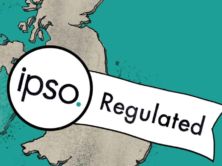(Credit: Samaritans, screenshot)
A December 2011 column by the BBC’s Jeremy Clarkson for UK News Corp-owned The Sun prompted “a complaint from five charities” to the UK Press Complaints Commission, according to a PCC’s news release.
As the Press Gazette summarized:
“Clarkson suggested in the article that trains should start moving again as soon as possible after a suicide, that the 200 people a year who end their lives in this way were ‘selfish’ and that the authorities should just ‘pick up the big bits of what’s left of the victim, get the train moving as quickly as possible’ – with further vivid comment in this vein.”
According to the PCC, the charities complained over “the article’s use of graphic imagery and a ‘flippant’ tone” toward suicide. Specifically, the five groups — Samaritans, Mind, Rethink Mental Illness, Sane and PAPYRUS Prevention of Young Suicide — argued the column violated the PCC guidelines on “intrusion into grief or shock.”
Those guidelines call for: sensitivity and discretion:
“i) In cases involving personal grief or shock, enquiries and approaches must be made with sympathy and discretion and publication handled sensitively. This should not restrict the right to report legal proceedings, such as inquests.
“ii) When reporting suicide, care should be taken to avoid excessive detail about the method used.”
The PCC reported that The Sun defended Clarkson’s “right…to hold a view that others strongly opposed” but “accepted that parts of the column had overstepped the mark.” The Sun also apologized and “agreed to training in reporting suicide sensitively,” according to the PCC.
The Samaritans’ head of communications, Nicola Peckett, told iMediaEthics by e-mail about the complaint’s resolution that :
“We’ve had a long and constructive relationship with The Sun and are pleased that we were able to resolve this complaint.
“It’s important for journalists to be aware of the sensitivities of reporting suicide. Whilst it’s vital to challenge stigma and de-mystify the issue, reporting needs to ensure it doesn’t lead to copycat deaths or intrude into the grief and shock of readers.
“The training we provide allows journalists to fully understand the effect their reporting can have on both vulnerable people and those bereaved by suicide.”
She explained that the Samaritans and the Sun haven’t set up a date for the training, which “basically takes journalists through our Media Guidelines for Reporting Suicide.” The Samaritans’ “media guidelines” — published here — are identified as a way to help the media report on suicide. The Samaritans note on their website: “A fine line remains between sensitive, intelligent reporting and sensationalising the issue.”
According to Peckett, “on average, we run around 10-20 sessions a year” for either “individual media outlets” or “group sessions” for many outlets. She noted that “later this year,” the Samaritans plan to have a revised set of guidelines.
We asked what are some of the Samaritans’ biggest concerns with media reporting on suicide. Peckett provided the group’s “submission to the Leveson Inquiry which outlines our approach to working with the media on the issue of suciide reporting and the key issues we would like addressed.” See here the link to the submission, which calls for “a proactive role” and “greater powers for the regulator…to prevent irresponsible coverage of suicide,” among other things.
Last year, the BBC apologized for Clarkson’s comments that public sector workers on strike should be “executed”, as we wrote. The comments prompted more than 21,000 complaints to the BBC. Clarkson also apologized.
We have written to the Sun for comment about the ruling and will update with any response.
iMediaEthics has previously written about issues related to reporting on suicides. For example: Last December, Kansas City, Missouri TV news station WDAF-4 had to report on the suicide of its meteorologist, Don Harman. The station said it waited to report on Harman’s death so it could contact Harman’s father, but the story “leaked out of the station,” according to the Kansas City Star.
In October of 2011, the Toronto Star public editor Kathy English questioned the newspaper’s guidelines recommending journalists only report that a death was from suicide if “there is some overriding public interest in doing so.”
We wrote in August 2011 when Australia’s press council released new guidelines for reporting on suicide.
Also in 2011, New Zealand advocacy group CASPER called for New Zealand to update its strict guidelines on reporting on suicides. CASPER stands for Community Action on Suicide Prevention Education & Research. New Zealand was reviewing its guidelines after its chief coroner, Judge Neil MacLean, called for more “responsible reporting” on suicide.
Hat Tip: Journalism.co.uk






